
Applied Data Science Coding in Python: How to do Binarization
Binarization is the process of converting a continuous or numeric variable into a binary variable. The binary variable can take on only two values, for example, 0 and 1, true and false, or yes and no. This process is often used in machine learning and data analysis to convert a continuous variable into a categorical variable that can be used as an input for a model.
In Python, one way to perform binarization is to use the pandas library and its cut() function. The cut() function takes in a numeric variable and a list of bin edges, and returns a new categorical variable that corresponds to the bins. For example, you can use the cut() function to convert a continuous variable into a binary variable by specifying the bin edges as [min_value, threshold, max_value]. All values less than or equal to the threshold will be assigned the value 0, and all values greater than the threshold will be assigned the value 1.
Another way to perform binarization in Python is to use the numpy library and its where() function. The where() function can be used to create a new binary variable by specifying a condition that separates the data into two groups. For example, you can use the where() function to convert a continuous variable into a binary variable by specifying the condition x > threshold. All values that meet this condition will be assigned the value 1, and all values that do not meet this condition will be assigned the value 0.
In summary, Binarization is the process of converting a continuous or numeric variable into a binary variable. In Python, one way to perform binarization is to use the pandas library and its cut() function. Another way to perform binarization in Python is to use the numpy library and its where() function. These methods can be used to convert a continuous variable into a binary variable by specifying a threshold or a condition that separates the data into two groups.
Binarization is a process of converting a continuous feature into a binary feature, also called thresholding. It is used in machine learning tasks such as image processing and text classification. In this process, we set a threshold value and all values above that threshold are set to one, and all values below that threshold are set to zero.
In Python, the scikit-learn library provides a class called Binarizer to perform binarization on a dataset. The class has a parameter called threshold that can be set to specify the threshold value. When the transform() method is called on an instance of the Binarizer class, it applies the threshold on the input dataset and returns a binary dataset.
In summary, Binarization is the process of converting a continuous feature into a binary feature by setting a threshold. The scikit-learn library in Python provides a class called Binarizer to perform binarization on a dataset. The class has a parameter called threshold that can be set to specify the threshold value. The transform() method can be used to apply the threshold and return a binary dataset.
In this Applied Machine Learning & Data Science Recipe, the reader will learn: How to do Binarization.
Essential Gigs
For only $50, Nilimesh will develop time series forecasting model for you using python or r. | Note: please contact me…www.fiverr.com
For only $50, Nilimesh will do your data analytics and econometrics projects in python. | Note: please contact me…www.fiverr.com
For only $50, Nilimesh will do your machine learning and data science projects in python. | Note: please contact me…www.fiverr.com
For only $50, Nilimesh will do your gis and spatial programming projects in python. | Note: please contact me before…www.fiverr.com